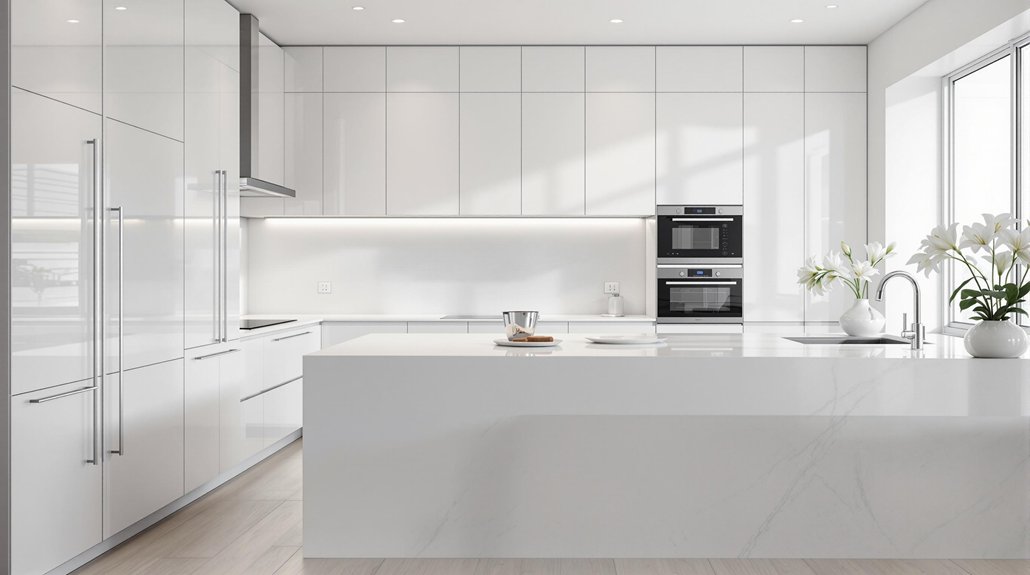
18 Modern White Kitchen Ideas That Are Clean and Minimalist
Modern white kitchens maximize spatial perception and luminosity through precise layering of matte and gloss finishes, reflective surfaces, and nuanced white tones. Color temperature—ranging from warm antique to cool optic whites—establishes contrasting atmospheres, while open shelving and minimal hardware emphasize a streamlined aesthetic. Strategic use of bold surfaces, monochrome worktops, and natural wood introduces visual hierarchy and texture, efficiently organizing space. High-contrast flooring and statement accents enhance visual expansion. Further insights reveal advanced techniques and curated design combinations.
Key Takeaways
- Layer varying shades and textures of white to create depth and subtle contrast while maintaining a cohesive minimalist look.
- Incorporate glossy finishes and reflective surfaces to maximize natural light and visually expand the kitchen’s footprint.
- Use handleless cabinetry and open shelving for a clutter-free, streamlined appearance that reinforces a clean modern aesthetic.
- Introduce bold accents like black quartz worktops or marble islands to add focal points without overwhelming the monochromatic palette.
- Balance the coolness of white with natural wood elements or soft lighting for warmth and inviting ambiance.
Why Choose a White Kitchen
A primary reason many homeowners opt for a white kitchen is its ability to maximize spatial perception and luminosity. White kitchens function as reflective surfaces, amplifying both natural and artificial light to create an expansive, airy environment—an especially valuable attribute in compact residential spaces. The chromatic neutrality of white enhances visual continuity, reducing boundaries between walls, cabinetry, and countertops. This seamless integration contributes to an uncluttered, minimalist aesthetic, reinforcing the perception of cleanliness and purity. Additionally, the inherent versatility of white kitchens allows for effortless adaptation to evolving décor trends, as accent colors or materials can be interchanged without disrupting the core visual scheme. However, these spaces necessitate disciplined maintenance protocols; high reflectivity accentuates stains and blemishes, requiring vigilant upkeep to sustain their pristine appearance. Greige cabinets, which offer timeless design versatility, can also complement white kitchens by adding subtle warmth and texture.
Selecting the Perfect Shade of White
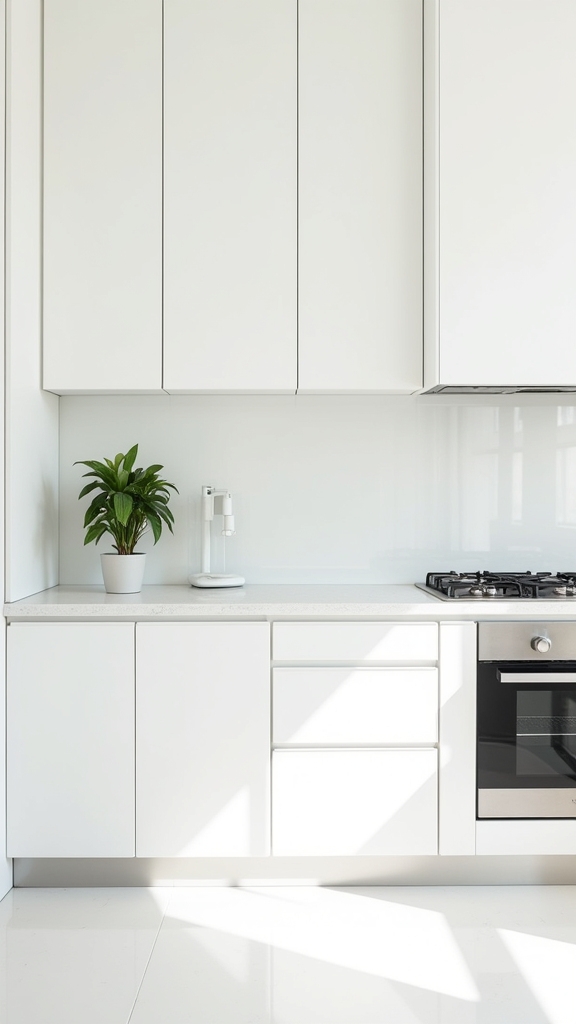
Selecting the ideal shade of white requires careful consideration of undertone—warm whites introduce softness, while cool whites offer a crisp, modern appearance.
Strategic layering of white tones across cabinetry, surfaces, and fixtures generates textural contrast and spatial depth.
Lighting conditions play a critical role, as both natural and artificial illumination can alter the perceived temperature and luminosity of the chosen white.
Warm vs. Cool Whites
When determining the ideal shade of white for a modern kitchen, understanding the nuanced distinction between warm and cool whites is essential for achieving the desired spatial and visual effect. Warm whites, such as Antique or Bone white, contain subtle undertones of yellow, red, or beige, introducing a sense of coziness and comfort. In contrast, cool whites, like bright or optic white, reflect more light due to blue or grey undertones, enhancing a kitchen’s sense of spaciousness and modernity. The selection of warm vs. cool whites directly impacts the perceived atmosphere, influencing whether the space feels inviting or ultra-modern. The following table highlights key differences:
| Characteristic | Warm Whites |
|---|---|
| Undertones | Yellow, Beige |
| Ambiance | Cozy, Inviting |
| Light Reflection | Moderate |
| Style | Shift, Homey |
| Example Shades | Antique, Bone White |
Layering White Tones
Understanding the influence of warm and cool whites sets the stage for exploring how layering multiple white tones can define a kitchen’s modern character.
The process of layering white tones involves selecting distinct yet harmonious whites—such as bright white cabinetry paired with bone white or antique white surfaces—to construct visual depth within the spatial envelope. This nuanced approach leverages the reflective properties of each shade, maximizing brightness and enhancing perceived volume, particularly in compact kitchens.
Textural variation—matte countertops against glossy tiles, for example—further intensifies the interplay of light and shadow, establishing a dynamic, yet cohesive, composition.
Strategic juxtaposition of warm and cool whites enables designers to evoke targeted atmospheres, ranging from crisp minimalism to inviting softness, all while maintaining a unified, minimalist aesthetic.
Impact of Lighting
How does illumination alter the perception of white within a modern kitchen? The impact of lighting is pivotal in defining the visual temperature and spatial dynamics of white surfaces.
Natural daylight intensifies bright whites, generating a sense of crisp cleanliness, while artificial illumination—dependent on bulb spectrum—shifts whites toward warmer or cooler undertones. Selecting the perfect shade of white hinges on understanding these interactions: warm-toned lights harmonize with off-whites for a softer ambiance, whereas cool-toned LEDs accentuate the contemporary sharpness of pure whites.
In addition, reflected light enhances spatial perception, amplifying brightness and perceived volume in compact layouts. Varying textures and finishes, when paired with strategic lighting, create multidimensional visual interest.
- Sunlight streaming across glossy white counters
- Recessed cool LEDs highlighting minimalist cabinetry
- Ambient pendants casting soft warmth over matte finishes
Combining White With Bold Accent Colours

Contrast serves as a fundamental design principle in modern white kitchens, where the integration of bold accent colours—such as vibrant reds or deep blues—establishes a visually dynamic environment.
The inherent neutrality of white cabinetry provides a clean canvas, amplifying the impact of vivid accent hues. Strategic placement of colourful bar stools, curated kitchenware, or expressive artwork introduces targeted visual emphasis, drawing attention to specific spatial zones without disrupting the kitchen’s minimalist geometry.
Incorporating accent tones through a statement backsplash or uniquely hued countertops adds depth and focal interest, maintaining spatial clarity while infusing individuality.
This calculated application of colour delineates zones of activity and interaction, ensuring that the minimalist ethos remains intact while fostering an atmosphere that is both engaging and architecturally cohesive.
Matt vs. Gloss Finishes

Beyond the interplay of white surfaces with bold accent colours, the tactile quality and reflective properties of finishes—specifically matt versus gloss—significantly influence the visual dynamics and spatial perception of modern kitchens.
Matt finishes offer a subtle, non-reflective surface, imparting a sophisticated, contemporary aesthetic that can soften traditional cabinetry and minimize glare. Conversely, gloss finishes, with their high reflectivity, amplify ambient light, visually expanding compact spaces and energizing darker environments.
Matt brings subtlety and sophistication, while gloss reflects light to energize and visually expand modern kitchen spaces.
The decision between matt vs. gloss finishes extends beyond maintenance considerations—gloss surfaces are easier to clean, while matt may require more upkeep. Strategic integration of both can generate compelling visual contrasts and depth.
- Smooth gloss cabinetry multiplying daylight across surfaces
- Deep matt islands anchoring open-plan layouts with understated elegance
- Subtle contrast lines where matt meets gloss, adding geometric intrigue
Choosing Complementary Flooring and Worktops
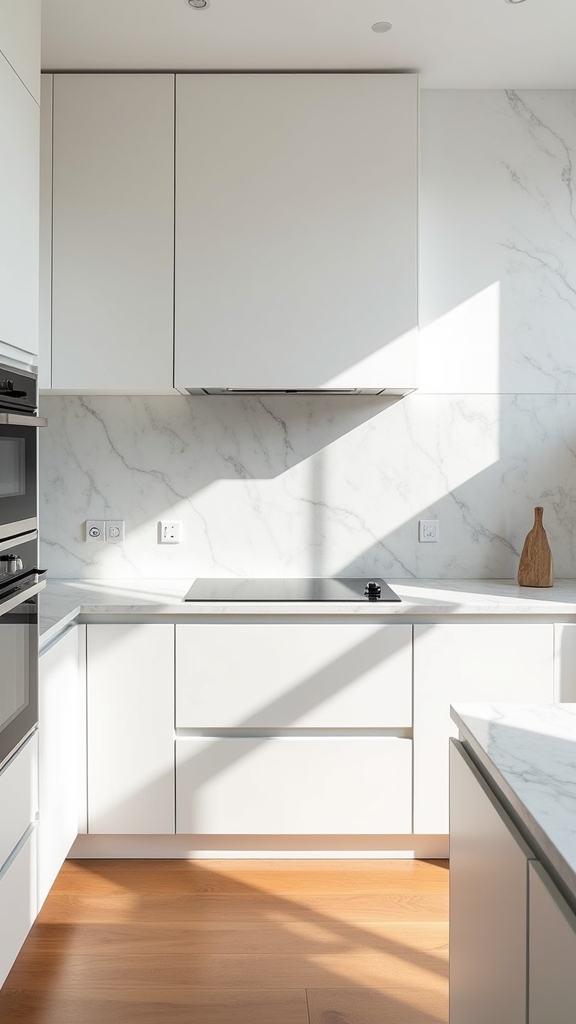
Selecting flooring and worktops for a white kitchen relies on interplay between contrast, texture, and spatial harmony.
Light wood or laminate floors can expand perceived volume, while darker flooring introduces depth and modernity.
Contrasting worktop surfaces—such as white quartz with grey veining or bold black countertops—create dynamic visual anchors within the minimalist scheme.
Contrasting Worktop Choices
When configuring a modern white kitchen, the interplay between worktop and flooring materials fundamentally shapes the spatial dynamics and overall visual coherence.
Contrasting worktop choices, such as black granite or quartz, establish a dramatic visual anchor in an otherwise light environment, amplifying depth and perimeter definition. White worktops with subtle grey specks provide nuanced texture, maintaining a seamless, monochromatic palette while avoiding sterility.
Incorporating bold hues—like deep blues or vibrant reds—on worktops introduces intentional focal points, breaking uniformity and allowing for controlled creative expression. The technical juxtaposition of laminate flooring and acrylic worktops allows for tailored color and texture coordination, enhancing the tactile and visual experience.
- Black worktops define strong linear contrasts against white cabinetry.
- White quartz surfaces with grey veining evoke understated elegance.
- Deep blue worktops punctuate minimalism with dynamic color accents.
Light vs. Dark Flooring
The relationship between worktop and flooring choices dictates the perceived scale and atmosphere of a modern white kitchen.
Light flooring, such as pale wood or laminate, amplifies luminosity and generates a seamless, expansive effect, visually enlarging the kitchen footprint. This approach aligns with Scandinavian design principles, emphasizing continuity and spatial clarity.
In contrast, dark flooring—ranging from espresso hardwoods to charcoal tiles—anchors the environment, providing dramatic contrast against white cabinetry and elevating visual depth.
Selecting complementary worktops is critical: white granite or quartz surfaces with subtle grey veining offer versatility, harmonizing with either light or dark flooring for a cohesive, durable finish.
For heightened visual interest, designers often pair light flooring with darker worktops or combine dark flooring with pale surfaces, optimizing modern minimalism.
Bold Statement Surfaces
Although a white kitchen offers a blank canvas, bold statement surfaces—such as granite or quartz worktops with pronounced veining or deep, saturated hues—establish immediate focal points and delineate zones within the spatial layout.
These surfaces not only anchor the visual hierarchy but also introduce textural contrast and chromatic depth. Black quartz worktops, for instance, generate a striking monochrome effect, intensifying the interplay between light cabinetry and dark surfaces.
Light wooden flooring amplifies brightness and spatial continuity, while darker woods or versatile laminates add dimensionality and modernity. Integrating bold colors or unique patterns into worktops accentuates the kitchen’s minimalist aesthetic, creating a dynamic yet cohesive environment.
- Jet-black quartz worktops juxtaposed with matte white cabinetry
- Pale oak flooring reflecting natural light across the space
- Granite surfaces with dramatic veining as a visual centerpiece
Cozy Cottage Inspiration
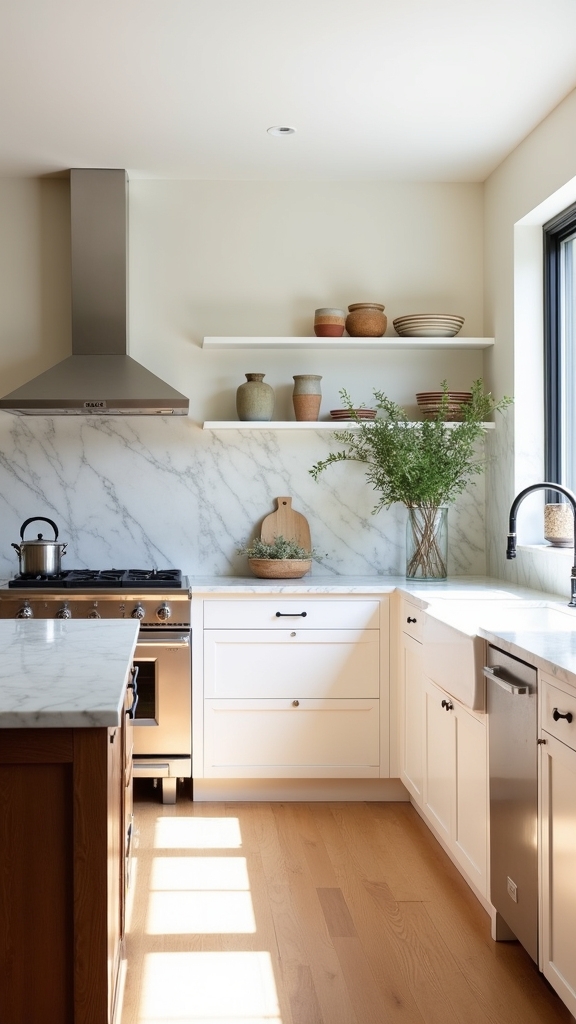
Many cozy cottage kitchens employ white cabinetry to optimize spatial perception and reflect ambient light, establishing a fresh and expansive environment. This strategic use of white enhances volumetric proportions within compact layouts, particularly effective in homes from the 1920s where modest footprints benefit from spatial augmentation. A ceiling rendered in a soft blue, such as Benjamin Moore’s Silvery Blue, introduces a visual plane that both contrasts and harmonizes with the cabinetry, evoking a tranquil atmosphere. The integration of hand-painted backsplash tiles introduces artisanal detailing, reinforcing the tactile, human-scaled aesthetic integral to cozy cottage kitchen design. Incorporating a white shiplap ceiling can further enhance the contemporary appeal of a kitchen, offering both aesthetic sophistication and a bright, airy feel. These elements collectively support a homey ambiance conducive to social interaction. The result is an inviting kitchen zone defined by light maximization, spatial clarity, and a measured balance of color and handcrafted texture.
High Contrast Design Ideas

Contrasting sharply with the soft, layered sensibility of cozy cottage kitchens, high contrast design in modern white kitchens leverages stark juxtapositions—such as black cabinetry or countertops set against pristine white surfaces—to maximize visual impact.
This approach employs deliberate material selection and finish variation to highlight architectural lines and spatial boundaries. Glossy finishes on white cabinetry reflect ambient light, amplifying spatial perception, while matte black elements anchor the design visually.
The interplay of Carrara marble islands with darker accents introduces both luxury and textural differentiation. High contrast design is not only visually dynamic but also functional; darker surfaces discreetly mask daily wear, making them ideal for urban environments.
The result is a kitchen that reads as sophisticated, bold, and meticulously curated.
- Black quartz countertops on a white high-gloss island
- Matte black cabinetry framing a marble waterfall island
- Linear pendant lighting casting sharp shadows on white walls
Granite countertops, with their extensive color options, provide a durable and heat-resistant surface that complements high contrast kitchen designs.
Minimalist and Neutral Spaces
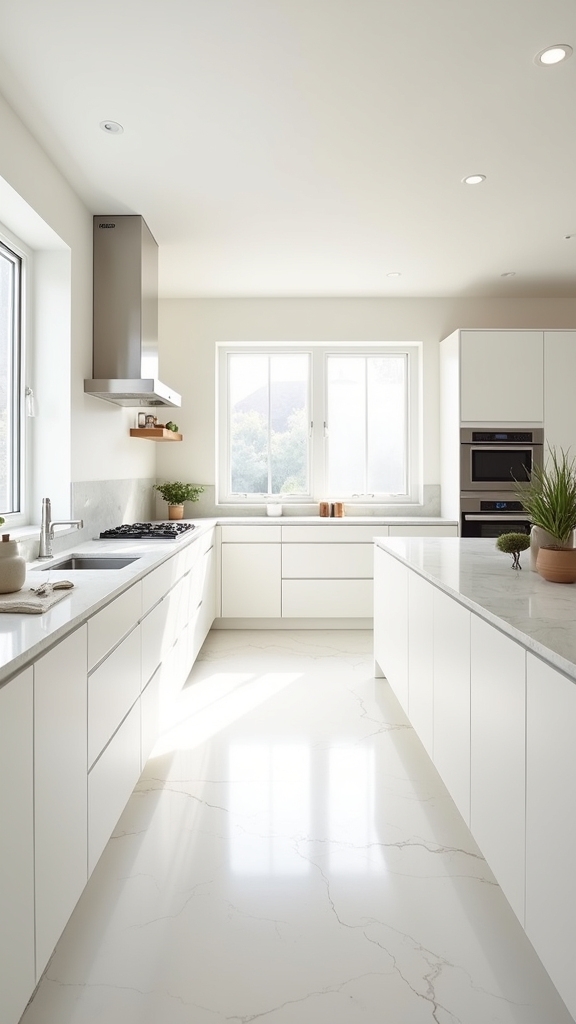
Minimalist and neutral kitchen spaces prioritize sunlit surfaces, where materials like Venetian plaster amplify natural illumination and generate visual depth. Understated color palettes, dominated by whites and subtle neutrals, facilitate a seamless flow between cabinetry, countertops, and spatial boundaries. The resulting composition draws attention to refined textures and spatial clarity, supporting an environment of calm functionality. Light greige cabinets reflect natural light, creating a bright ambiance and optimizing space in smaller kitchens, with the reflective properties of greige enhancing room illumination and fostering warmth.
Sunlit Surfaces and Texture
Abundant natural light across pristine surfaces amplifies spatial perception in neutral kitchen environments, generating an atmosphere of openness and luminosity.
In white kitchens, the interplay of sunlight and reflective materials—such as Venetian plaster walls—maximizes brightness while minimizing visual clutter. Textural contrast is introduced through select elements, enhancing depth without compromising minimalism.
Incorporating natural textures like pale wood accents or honed stone countertops introduces tactile warmth, balancing the cool clarity of a monochromatic scheme. Open shelving, often employed in minimalist layouts, further boosts the sense of spaciousness and allows curated objects to become part of the visual composition.
- Sunbeams cascade over seamless marble countertops, highlighting their subtle veining.
- Shimmering Venetian plaster walls diffuse natural light, intensifying the kitchen’s airy feel.
- Light-toned wood shelving softens the space, providing organic texture amidst crisp white cabinetry.
Understated Color Palettes
A spectrum of soft whites, off-whites, and muted earth tones defines the understated color palettes prevalent in modern white kitchens, establishing a harmonious and tranquil visual field.
Minimalist and neutral spaces rely on these subtle chromatic variations to create depth through spatial layering—cabinetry, countertops, and flooring often exhibit distinct textures while remaining cohesive in tone.
Venetian plaster or matte finishes are frequently specified, enhancing reflectivity, amplifying natural light, and maintaining a visually uncluttered environment.
Strategic contrast—such as pairing luminous white cabinetry with darker hardware or stone surfaces—introduces focal points without disrupting the minimalist ethos.
Understated color palettes in white kitchen ideas enable seamless integration of personal decor, offering flexibility for accentuation with curated accessories or artwork, while preserving the space’s serene, sophisticated aesthetic.
Glamorous White Kitchens
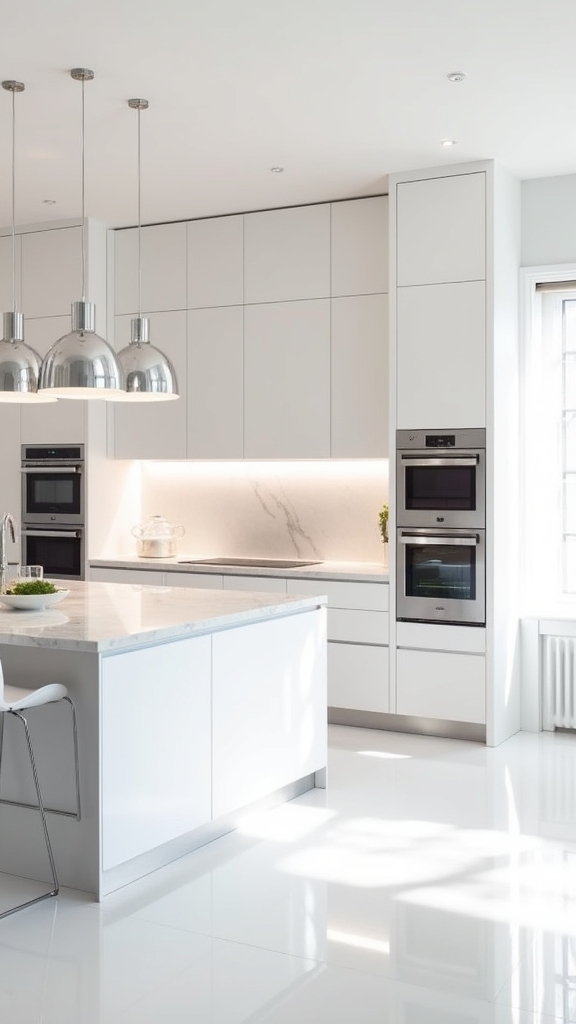
Elevating spatial sophistication, glamorous white kitchens integrate high-contrast elements—such as bold black accents and luxurious Carrara marble surfaces—to achieve a visually arresting environment.
The interplay of high-gloss cabinetry and polished stone amplifies ambient light, fostering a sense of expansiveness. Strategic layering of tactile materials—matte ceramics juxtaposed with reflective metals—heightens both depth and architectural interest.
High-gloss surfaces and polished stone combine to amplify light, while layered textures add depth and striking architectural dimension.
Glamorous white kitchens frequently employ curated accessory palettes, utilizing metallics or saturated hues to punctuate the monochrome scheme without overpowering the pristine aesthetic. Custom furnishings, such as sculptural bar stools or an artisan dining table, contribute to spatial individuality and design coherence.
This approach results in a harmonious setting where technical precision and visual opulence coalesce.
- Sleek black pendant lighting suspended over a marble island
- Polished brass hardware shimmering against white lacquered cabinets
- Textured velvet seating accentuating a streamlined breakfast nook
A statement gold light fixture can be seamlessly integrated into the design to enhance the ambiance while maintaining the kitchen’s elegant aesthetic.
Preserving Original Features
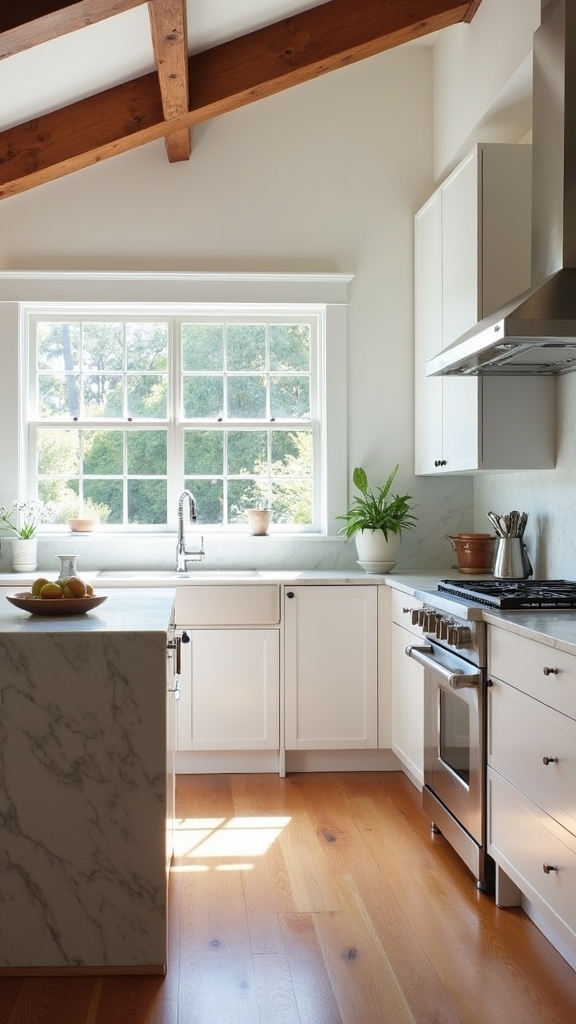
By retaining original architectural features, a modern white kitchen achieves a dynamic juxtaposition of historical character and contemporary minimalism.
Exposed beams and brickwork, when left intact, introduce tactile textures that contrast with the smooth, reflective surfaces of modern cabinetry and countertops.
Vintage cabinetry and antique hardware become focal points, their patina and intricate detailing accentuating the simplicity of the white palette.
Preserved original flooring or heritage tiles offer visual grounding, delineating circulation paths and anchoring the kitchen’s spatial flow.
Original windows and door frames, when preserved, optimize daylight penetration, amplifying the inherent brightness of a modern kitchen.
This synthesis of old and new not only maintains functional efficiency but also imparts enduring narrative depth, ensuring the kitchen remains contextually rich and visually compelling.
Mediterranean-Inspired White Kitchens
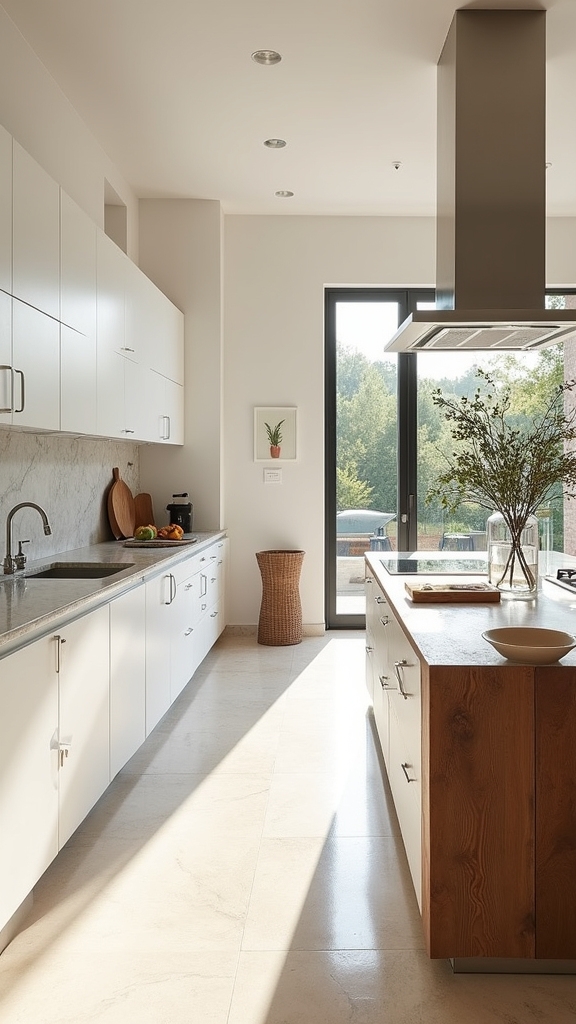
Mediterranean-inspired white kitchens utilize rustic tiles and textural surfaces to introduce tactile contrast against smooth, whitewashed cabinetry.
Sunlit open layouts maximize natural illumination, enhancing spatial flow and highlighting material variation.
This configuration emphasizes both visual depth and a seamless connection between indoor and outdoor environments.
Rustic Tiles and Textures
Terracotta tiles underfoot introduce a tactile foundation to white kitchens, setting the stage for a Mediterranean-inspired aesthetic defined by rustic textures and organic materials.
The use of rustic tiles—whether authentic terracotta or hand-painted ceramics—creates a visually dynamic surface, contrasting with the crispness of white cabinetry. Whitewashed finishes on millwork and exposed ceiling beams further accentuate the interplay of smooth and textured planes, promoting visual cohesion while preserving a minimalist environment.
Natural stone elements, such as limestone or marble tile, enhance the organic context and reinforce the spatial narrative of warmth and subtle complexity. Earthy-toned accessories, thoughtfully integrated, harmonize with these surfaces, preventing visual monotony.
- Rough-hewn terracotta tiles create grounding, patterned geometry beneath the kitchen space
- Hand-painted ceramic backsplashes offer intricate, artisanal focal points
- Reclaimed wood shelving introduces tactile contrast against smooth, white walls
Sunlit Open Layouts
Building upon the tactile foundation established by rustic tiles and organic textures, sunlit open layouts prioritize spatial fluidity and maximized illumination. High ceilings and expansive windows define these Mediterranean-inspired kitchens, where white cabinets reflect ambient daylight, amplifying the sense of openness. Architectural elements such as arched doorways or windows anchor the layout, introducing curvature that contrasts with linear cabinetry. Open shelving, integrated alongside whitewashed finishes, furthers the minimalist aesthetic while enabling curated display of ceramics or verdant foliage. The interplay between structural volume and restrained color palette guarantees an environment that is both visually cohesive and functionally efficient.
| Design Element | Spatial Impact |
|---|---|
| High Ceilings | Enhanced vertical openness |
| Arched Doorways | Softened visual shifts |
| Open Shelving | Personalized minimalist zone |
Timeless Classic Styles
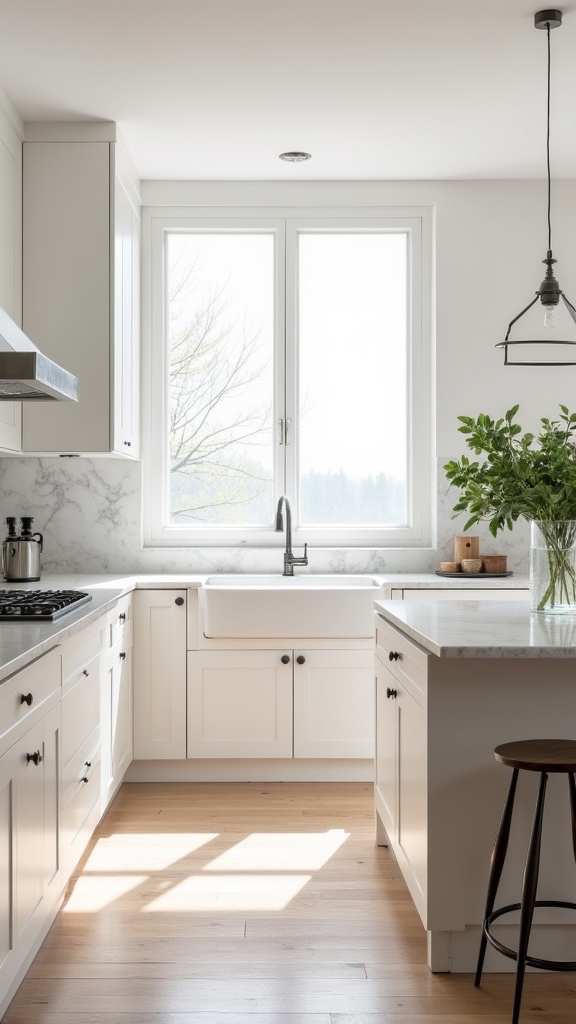
When executed with precision, timeless classic styles in white kitchens rely on foundational elements such as Shaker cabinetry—defined by rectilinear profiles and recessed paneling—which establish a streamlined visual continuity across the space. This timeless look is further articulated through beadboard backsplashes and traditional crown moldings, introducing subtle dimensionality without compromising minimalism. Spatial composition is enhanced by the integration of natural materials, such as marble countertops and wooden accents, which offer tactile contrast and warmth. Classic white kitchens leverage a monochromatic palette, providing a neutral backdrop that uplifts vintage-inspired fixtures like farmhouse sinks or pendant lights, anchoring the aesthetic with historic resonance. These technical choices deliver enduring sophistication while accommodating evolving trends. Incorporating artisanal finishes like Venetian plaster can add unique, textured focal points, enhancing the classic kitchen design. – Crisp Shaker cabinetry stretching wall to wall – Honed marble counters paired with beadboard backsplash – Gleaming farmhouse sink beneath a classic pendant light
Small Space Solutions

While classic white kitchens evoke enduring elegance, small space environments demand strategic spatial optimization through technical design decisions.
In small white kitchens, glossy surfaces are employed to maximize light reflectivity, visually expanding confined layouts. Open shelving systems integrate efficient storage with decorative display, promoting both accessibility and an uncluttered aesthetic.
The adoption of multi-functional elements, such as a white marble island doubling as both workspace and dining area, increases operational versatility without encroaching on limited floor area. Handleless cabinetry further streamlines the visual field, reducing interruptions and reinforcing a minimalist profile.
Light-toned wooden flooring introduces warmth while preserving a sense of expansiveness. Collectively, these technical interventions transform small white kitchens into spatially efficient, visually cohesive zones that prioritize both modern aesthetics and functional performance. To maximize space, consider compact and multi-functional appliances that seamlessly integrate into small kitchen areas.
Brightening Dimly Lit Kitchens
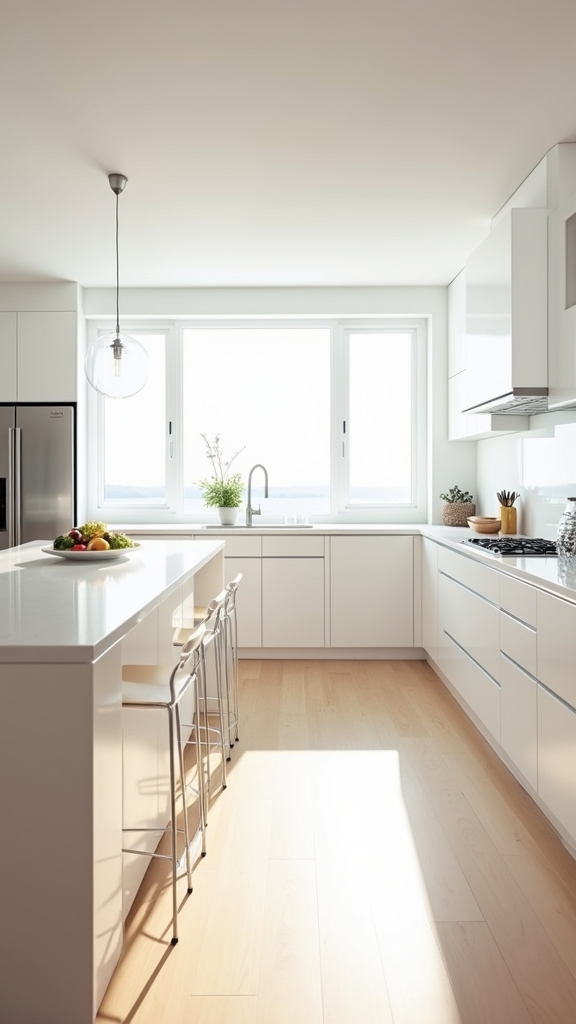
In kitchens with limited illumination, optimizing spatial brightness relies on maximizing natural light ingress through architectural elements such as expansive windows or skylights. The use of reflective surfaces—glossy white cabinetry and countertops—enhances light diffusion, visually enlarging the environment. Precision in lighting placement, including under-cabinet and pendant fixtures, guarantees targeted illumination and complements the overall luminous effect. Incorporating decorative elements such as colorful patterns or chic towel ladders can add sophistication and visual interest while maintaining a minimalist look.
Maximizing Natural Light
By integrating expansive windows or glass doors into the architectural layout, a modern white kitchen maximizes exposure to natural light, fundamentally altering spatial perception and brightness.
This strategy leverages transparency and spatial connectivity, dissolving boundaries between indoor and outdoor environments. Optimized fenestration permits daylight to penetrate deep into the kitchen, reducing reliance on artificial illumination and enhancing the visual volume of the space.
The use of open shelving, as opposed to closed cabinetry, further facilitates light flow, supporting a sense of openness. Complementary LED fixtures calibrated to mimic daylight supplement areas where natural light is insufficient, ensuring consistent luminosity throughout.
- Floor-to-ceiling windows frame outdoor vistas, saturating interiors with daylight.
- Glass sliding doors create seamless connections and amplify light diffusion.
- Open shelving systems enable unobstructed light passage, reinforcing an airy ambiance.
Reflective Surfaces Matter
Reflectivity functions as a pivotal design mechanism in modern white kitchens, particularly when addressing the challenge of limited natural illumination. Reflective surfaces—such as high-gloss cabinetry, polished metal fixtures, and glossy tile backsplashes—serve to amplify incidental light, increasing both perceived brightness and spatial volume.
This enhanced luminosity counteracts shadows and mitigates the visual impact of dark corners, yielding a more expansive and inviting environment. The deployment of white reflective surfaces not only sustains minimalist aesthetics but also establishes focal points, accentuating the purity and simplicity of the design.
Additionally, gloss finishes on countertops and cabinets mask minor smudges, reducing visible maintenance requirements. In sum, the strategic utilization of reflective surfaces transforms dimly lit kitchens, optimizing both functional brightness and visual clarity without reliance on artificial lighting schemes.
Strategic Lighting Choices
How can spatial illumination be precisely engineered in modern white kitchens where natural light is insufficient? Strategic lighting choices become essential for optimizing both functionality and aesthetics.
Incorporating under-cabinet LED strip lighting directly targets shadow-prone countertops, ensuring continuous task visibility. Pendant lights act as both luminous focal points and sources of targeted illumination above islands or dining zones, visually anchoring the layout while enhancing brightness.
Glossy finishes on cabinetry and surfaces further amplify lighting effects by reflecting and diffusing luminance throughout the space. Dimmable fixtures provide adaptability, allowing for seamless shift from high-intensity prep environments to subdued dining atmospheres. Light-colored or transparent fixtures maximize diffusion, maintaining spatial openness and visual continuity.
- Under-cabinet LED strips casting crisp, linear illumination onto pristine countertops
- Glossy white cabinetry reflecting pendant lighting for balanced luminance
- Sleek, dimmable fixtures above the island for adaptive atmospheric control
Adding Pops of Colour

While the minimalist foundation of a modern white kitchen establishes a sense of spatial clarity, integrating deliberate pops of colour introduces both visual hierarchy and focal interest. Strategic placement of vivid artwork or decorative objects serves as an anchoring element, drawing the eye within the tonal expanse of white surfaces. Pops of colour can be deployed through functional accessories—dishware, utensils, or small appliances—creating a chromatic accent without disrupting the kitchen’s streamlined silhouette. Bold-coloured bar stools or cushions provide spatial contrast against white cabinetry, generating a dynamic interplay between form and hue. The inclusion of bright plants or fresh flowers enhances the kitchen’s sensory environment, infusing natural warmth and organic vibrancy. Each application of pops of colour is purposeful, preserving the kitchen’s minimalist ethos while enhancing visual engagement. Statement lighting in bright colors, such as globe pendant lights, can infuse liveliness and enhance depth over the kitchen island or dining area.
Powerful Pigment Pairings
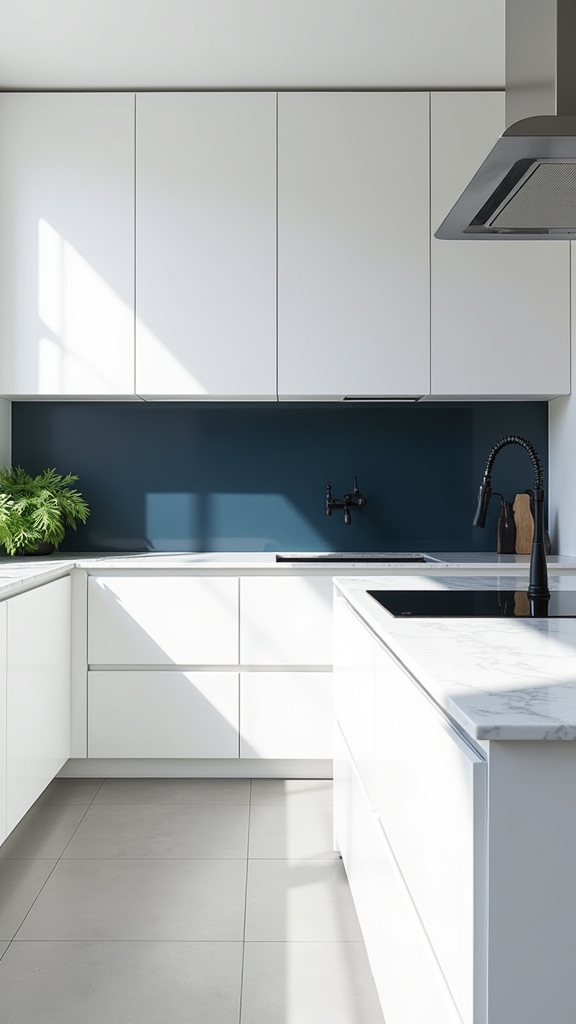
When saturated pigments such as bubblegum pink are introduced into a modern white kitchen, the resulting chromatic interplay produces intentional focal points that disrupt visual uniformity.
The deliberate integration of powerful pigments—whether applied to bar stools, backsplashes, or accent appliances—creates a vivid contrast that enhances spatial perception and lends dimensionality to otherwise minimalist environments.
These high-contrast elements act as visual anchors, guiding the eye and reinforcing the geometric clarity of the space. The presence of powerful pigments not only punctuates the prevailing white palette but also embodies contemporary design principles by allowing personal expression within a restrained aesthetic.
Strategic placement of vibrant hues optimizes the kitchen’s visual dynamism while preserving its structural coherence.
- Bubblegum pink bar stools aligned along a pristine white island
- Cobalt blue pendant lighting suspending above white quartz countertops
- Emerald green cookware displayed against glossy white cabinetry
Incorporating Natural Wood Elements
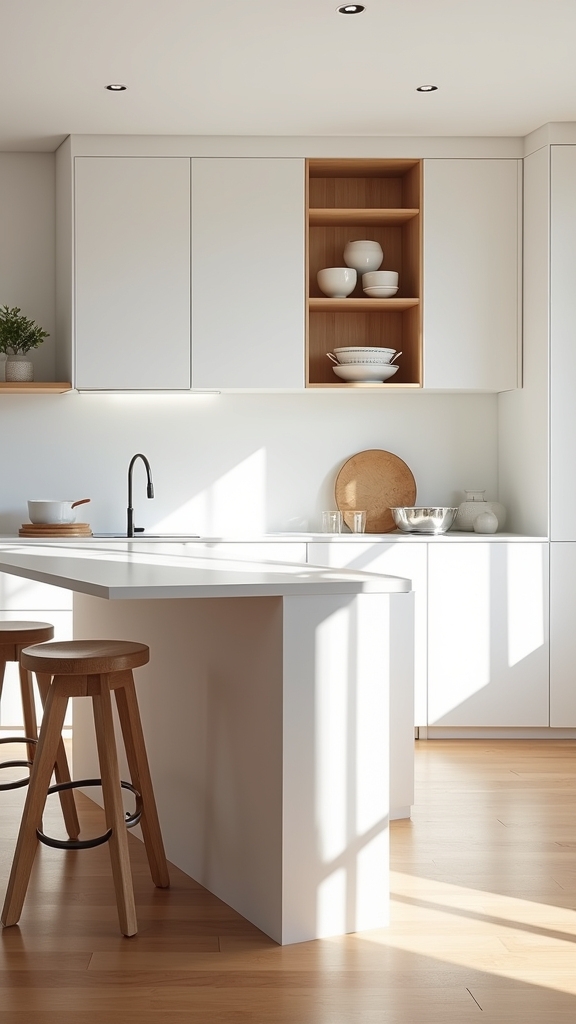
Although modern white kitchens are defined by their crisp minimalism and reflective surfaces, the strategic introduction of natural wood elements establishes a tactile counterpoint that enriches spatial composition.
Within kitchen design, light wooden flooring amplifies luminosity while imparting a warm, inviting undercurrent that softens the visual austerity of white cabinetry. The interplay of organic grain patterns and smooth, pristine finishes generates a dynamic yet balanced atmosphere.
Selecting wood with a natural finish accentuates authentic materiality, allowing the inherent character of the timber to harmonize with the surrounding whiteness. Contrasts between varying wood tones and white surfaces foster depth and layered dimension, ensuring the design remains contemporary yet approachable.
Thoughtfully integrated, natural wood elements transform sterile minimalism into an environment of enhanced comfort and visual sophistication.
Open Shelving for Display and Storage
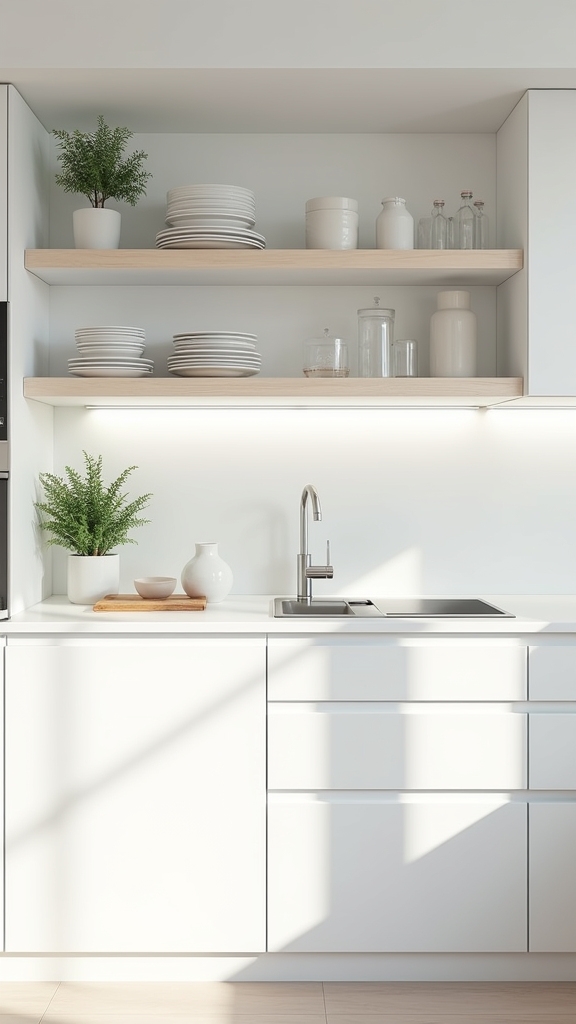
Open shelving, integrated into modern white kitchens, introduces intentional visual permeability that disrupts monolithic cabinetry lines and enhances spatial flow.
This design strategy boosts accessibility for frequently used items and facilitates curated display opportunities, transforming utilitarian objects into expressive design elements.
The interplay of open shelving with a white palette amplifies perceived space and light, particularly in compact kitchen layouts, while mitigating visual clutter.
Contrasting materials—such as wood or matte metal—on open shelving further enrich the spatial narrative, establishing tactile and chromatic differentiation against the minimalist white backdrop.
Wood or matte metal shelving introduces tactile contrast and chromatic depth, elevating white kitchens beyond minimalist uniformity.
Rigorous organization and minimalistic styling are imperative to preserve clarity and prevent sensory overload.
- Plates and glassware arranged in linear sequences, reflecting symmetry and order
- Cookbooks juxtaposed with sculptural ceramics, introducing eclectic focal points
- Warm wood shelving against gloss-white walls, generating dynamic visual contrast
Frequently Asked Questions
What Is Replacing the White Kitchen?
Current color trends indicate a shift from monochromatic white kitchens to spatial compositions utilizing beige, greige, and earth tones. Visual emphasis shifts to two-tone cabinetry, natural materials, and bold accents, enhancing texture, depth, and individualized kitchen environments.
How Do You Style a Modern White Kitchen?
Styling a modern white kitchen emphasizes spatial clarity and visual cohesion. Texture contrast is achieved through matte or gloss finishes, while sleek, handleless cabinetry, open shelving, and dark or wooden accents introduce layered interest without disrupting the minimalist flow.
What Is the Easiest Color Kitchen to Keep Clean?
When considering color choices for kitchen maintenance, white surfaces offer superior visual emphasis on cleanliness due to high reflectivity and spatial clarity. This color facilitates early detection of smudges, promoting consistent hygiene and making routine cleaning processes more efficient.
How to Make a White Kitchen Less Clinical?
To diminish a clinical atmosphere in a white kitchen, spatial designers recommend integrating warm accents, such as wooden textures, varied white tones, and natural materials, while employing layered lighting and visually distinctive accessories to enhance depth and tactile richness.
Conclusion
In conclusion, modern white kitchens leverage spatial amplification and light reflection to create visually expansive, streamlined environments. The integration of technical finishes—whether matt or gloss—alongside complementary surfaces such as quartz or natural wood, cultivates both functional and aesthetic harmony. Strategic deployment of accent colours and open shelving enhances depth and visual interest without compromising minimalism. Ultimately, selecting the ideal white palette and textural interplay is fundamental for achieving a balanced, clean, and architecturally coherent kitchen space.
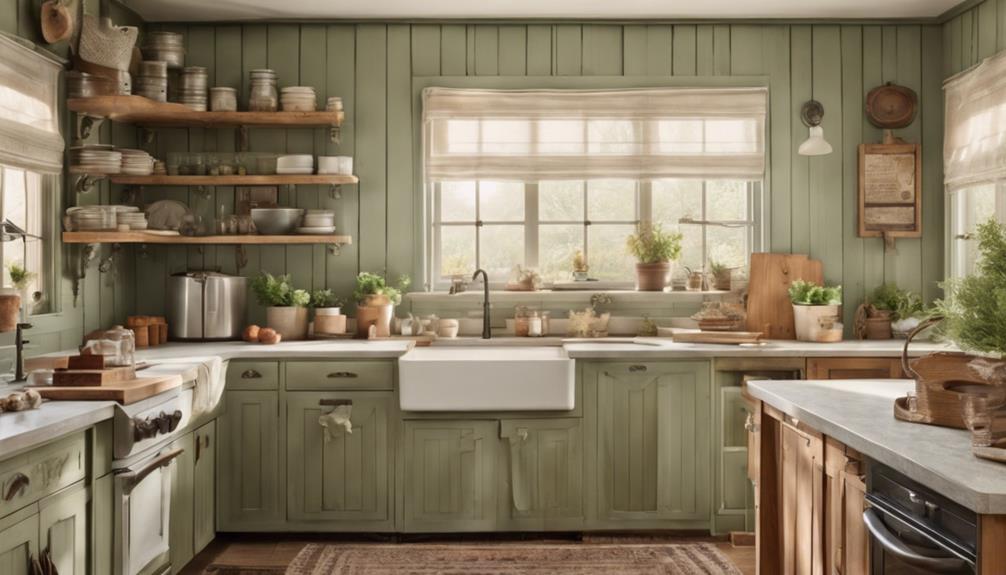

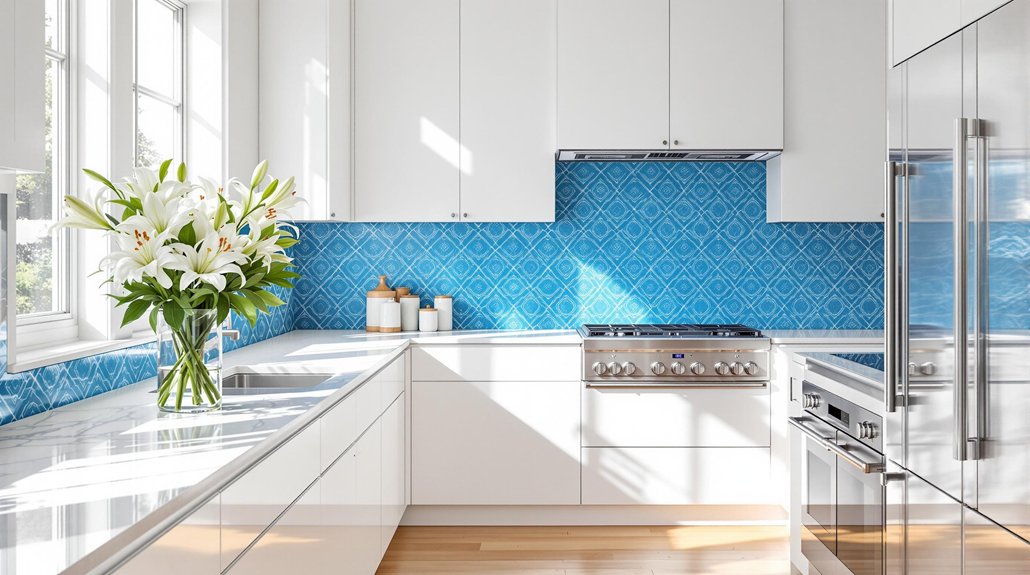
Leave a Reply